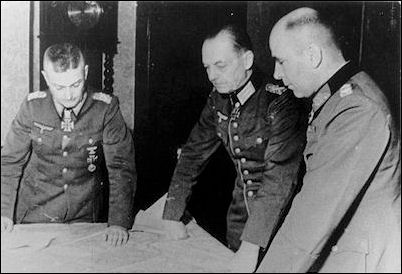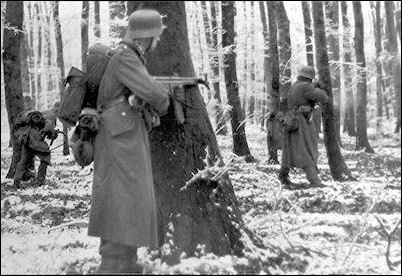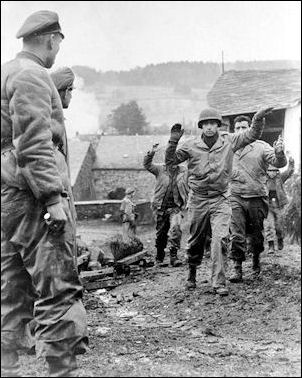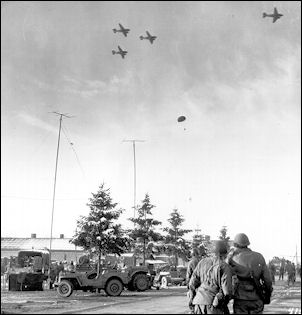![]()

Battle of the Bulge
In the summer of 1944, while Himmler's SS men were busy rounding up supposedly disloyal Army generals, Allied troops were busy blasting their way off the Normandy beachheads and into northern France.
German troops attempting to regroup for a massive counter-attack had instead suffered a crushing defeat when they were trapped in a pocket around Falaise. The Germans subsequently withdrew from northern France and then exited Paris amid a Resistance uprising. Fortunately the treasured city was left largely undamaged by the departing Germans as senior commanders turned a deaf ear to vengeful orders from Hitler. The city was formally liberated on August 25, 1944, by Free French troops.
Soon tank columns of the U.S. 3rd Army led by General George Patton were roaring eastward toward Germany so fast they risked running out of fuel. The amazing American and British-Canadian success continued with the liberation of Verdun, Dieppe, Artois, Rouen, Abbeville, Brussels and Antwerp. At the same time, Allied troops staged Operation Dragoon, a seaborne invasion of southern France, then pushed northward to link up with Patton. By mid-September, American troops had reached the Siegfried Line, a series of defensive fortifications stretching along Germany's western border.
ADVERTISEMENT By now, Hitler had lost over 500,000 soldiers in the West. It seemed the Western Allies were unstoppable and German commanders braced themselves for the inevitable invasion of the Fatherland. However, they were astounded when the entire Allied advance unexpectedly slowed down and then halted completely.
Despite appearances, the Western Allies needed to regroup. Supply lines had become dangerously overstretched, hampering the delivery of vital war materials including Patton's gasoline. Field Marshal Montgomery also needed to recover following Operation Market Garden, a daring airborne attack he had launched in September, intending to pierce the German front lines in southern Holland at Arnhem, seize a key bridge, and cross the Rhine River into Germany's industrial heartland. Unfortunately, British and American troops involved in the assault parachuted into the midst of 2nd SS Panzer Corps which had gathered there by coincidence to refit and resupply its tank troops. The result was a costly failure with nearly eight thousand casualties.
At this point, rather than sit back and allow the Western Allies to regroup, Hitler decided to act. Although weary in mind and body, the old gambling instincts were still there. And so he picked a spot on the map and decided to place all of his chips. To the great surprise of his generals, he ordered a stunning new offensive reminiscent of the brilliant Blitzkrieg assault four years earlier that had overwhelmed the French Army. His idea was to take advantage of the foggy weather, typical for mid-December, to plunge a force of 250,000 men through the lightly defended Ardennes Forest, cross the Meuse River, and then push northward to Antwerp, capturing it within a week.
But the plan came with a big price tag. To fill out the ranks, Hitler would need to draw thousands of men from the Russian Front where some 300 Soviet divisions were presently massing for their own invasion of Germany. Nevertheless, to Hitler it was worth the risk. It offered a chance to split apart the all-powerful American 1st and 3rd Armies, and in the accompanying confusion, crush British and Canadian positions along the Belgian-Dutch border. Additionally, the capture of Antwerp would rob the Allies of their only forward supply port.
The political fallout of this shocking victory, Hitler calculated, would be a rift between the British and Americans, thereby collapsing the Western Alliance, thus allowing him to transfer all of his forces to the Russian Front in time to thwart the Soviet invasion.
The two men chosen to command the offensive, Field Marshals Model and Rundstedt, listened in disbelief to the fantastical plan, knowing they had insufficient manpower and equipment to pull it off. But Hitler explained it yet another way. He cited the historical exploits of Frederick the Great, who had been in a similar bind two centuries earlier, only to launch a surprise attack against a vastly superior force, causing the alliance against him to dissolve, resulting in a spectacular victory.
Now, as then, the element of surprise would be the key. And in this regard nothing was left to chance. To keep the Allies from detecting their plans the Germans used a clever variety of deceptive tactics including a flurry of fake radio messages sent to non-existing frontline command posts, false rumors spread in public places for anyone to overhear, and relied primarily on secretive face-to-face conversations to relay the actual battle plans. At the same time, three whole armies, including twelve Panzer tank divisions, were quietly rolled into position for the offensive using a piecemeal approach to avoid detection.
Along with the element of surprise, the Germans needed to sow confusion to succeed. Here one of the more interesting exploits of the war unfolded, the brain child of Hitler himself. A special "School for Americans" was set up by SS spy master Otto Skorzeny to train 2,000 German commandos to speak and behave like American soldiers. Using captured uniforms and Jeeps, the commandos intended to confuse U.S. troops in the zone of attack by giving bad directions, mixing up road signs, killing dispatch riders, cutting phone wires, and would try to generate panic by depicting a hopeless situation to anyone who would listen.
At 5:30 a.m. on Saturday, December 16, 1944, it all began. The offensive, which Hitler code named Operation Autumn Fog, erupted with an hour-long artillery barrage along an eighty-five mile front in the Ardennes which was thinly defended by six American divisions. Three of the divisions were new and had no battle experience while the remainder were experienced but tired-out men sent to recuperate in what had been the quietest sector of the Western Front. Now they watched in amazement, peering through the morning mist as 2,500 tanks and self-propelled guns, accompanied by 18 infantry divisions, rumbled toward them over ground lightly covered with new-fallen snow.
Outnumbered three-to-one, and with no air support due to the heavy fog, the Americans knew they were in a terrible jam. Some yielded to a frenzied survival instinct and fell into a disorderly retreat. Others dug in their heels, aimed their rifles and held their ground, falling back only at the very last moment. An American eyewitness recalled the turmoil: “Aid stations overflowing, wounded men being evacuated by Jeep, truck, ambulance, anything that could roll, walking wounded…vehicles off the road, mired in mud or slush or damaged by gunfire…signal men trying to string wire to elements to cut off or repair [communication] lines which were being shot out as fast as they were put in.”
The German success continued unhindered for five foggy days, creating a 50-mile westward bulge in the lines, which gave the battle its popular name. American losses included a mass surrender of 7,500 soldiers, the single worst defeat for U.S. troops during the entire war in Europe. At Malmedy, in the northern part of the front, 81 unarmed American POWs were shot dead by Waffen-SS troops.
Meanwhile, several jeeploads of Skorzeny's imposters penetrated the lines and caused disruption as planned. Given the vastness of the front, their overall impact was rather limited. However, one team had a huge impact, chiefly resulting from their capture by suspicious Americans. During interrogation, they revealed details of the whole commando mission. As a result, the news flashed all along the front that German saboteurs were masquerading as Americans. This was a psychological blow to the beleaguered Americans, creating an atmosphere of widespread mistrust. Americans who didn't know each other beforehand now demanded answers to off-the-cuff trivia questions such as who had won the last World Series in baseball.
At his headquarters in Versailles, Allied Supreme Commander, General Dwight D. Eisenhower, was genuinely surprised Hitler had managed to scrape together enough resources to launch an offensive of this magnitude. His top aide, General Omar Bradley, Commander of U.S. troops in Europe, immediately sent in reinforcements. As they arrived, the German advance slowed, resulting in uneven progress all along the front.
By Thursday, December 21st, the Germans had hit a significant roadblock in the middle of the front at Bastogne in southern Belgium. To prevent this key city from falling into German hands, the 101st Airborne Division had been rushed in and formed defensive lines around the city, keeping the Germans at bay despite withering artillery fire. Inside the city were Americans from all corners of the battlefield who wound up there for one reason or another. When a German military delegation finally approached the heavily-surrounded Americans and demanded surrender, General Anthony McAuliffe's surprise response was "Nuts."
News of this spread and Americans with nothing to smile about till now were amused. Morale began to improve, along with the weather. On the morning of December 22nd, the fog finally lifted and hundreds of Allied planes took to the skies, dropping parachuted supplies into Bastogne, and machine-gunning all things German.
Hitler's commanders knew they were in trouble. The original plan called for a sweeping northward movement across the Meuse River onto Antwerp to trap the Allied armies within a week. Along the way, they were supposed to capture Allied fuel depots to keep the tanks rolling. But after a week they had barely reached the Meuse, failed to capture any fuel, and were facing increasing counter-attacks from a numerically superior Allied force that had caught its breath and regrouped. Now, like so many times in the past, the generals asked Hitler for permission to scrap the original plan and improvise due to the changed conditions. Once more, and for the last time in his life, Hitler said no.
It would be, as always, the frontline German who would pay for Hitler's stubbornness. Some of the troops were actually sixteen-year-olds pressed into military service by the Nazis. Raised according to the tenets of the Hitler Youth program, which emphasized the glory of a heroic death for the Fatherland, the emboldened teens were prone to behave recklessly on the battlefield and died by the hundreds for no reason. Allied soldiers who shot them, seeing only anonymous grey-clad figures in the distance, were both saddened and angered when they viewed the bodies up close, realizing Hitler was now gambling with the lives of boys in the West.
On Christmas Day 1944, Hitler took a little time off to celebrate the holiday with his staff, even sipping a glass of wine, a rarity for him. The next day, the wrath of the entire Western Alliance was loosed upon his troops, from the air and on the ground. Bastogne, which had been cut off for a week, was relived as a column of Patton's tanks broke through from the south.
Operation Autumn Fog was doomed. The gamble had failed. Shouting matches and arguments erupted at Hitler's headquarters. Even his oldest comrade, Hermann Göring, pleaded with Hitler to consider seeking an armistice to end the war. But the Supreme Commander would have none of it. Instead he ordered 25,000 relief troops rushed to the Ardennes and also threatened to have Göring shot if he tried to make his own peace agreement.
Autumn Fog would continue, the Führer insisted. Remarkably, he now ordered a second smaller offensive further southward to begin on New Year's Day to draw Allied troops away from the Ardennes. Once this succeeded, he declared, the northward drive to the Meuse would resume and the troops would achieve victory by relying on their fanatical zeal as Nazis to simply outlast the Allies.
By this time, however, with regular radio communications resumed, the British were deciphering the whole German strategy via Enigma, a duplicate of the Wehrmacht's top-secret cryptographic machine. They relayed each of the Führer's military directives directly to General Eisenhower. As a result, the New Year's offensive lasted just one day and the drive to the Meuse never resumed. Two days later, January 3, 1945, the Americans began an intensive two-pronged attack designed to break apart the original bulge the Germans had forged. Here the Germans caught a break as foggy weather dominated once more and all roads became very icy. American progress was hampered by the weather along with the skillful defensive tactics employed by German field commanders.
However, the Americans kept up the pressure, aided by the addition of British forces led by Field Marshal Montgomery, who was also given temporary command of the American 1st and 9th Armies in his area north of the bulge. Montgomery's combined force closed in from the north while Patton's 3rd Army came up from the south, forming a giant noose around the German position. Hitler was left with no alternative but to turn his tanks and soldiers around and send them all back toward Germany. Some units didn't escape in time, including over 20,000 men captured by the Americans east of Bastogne on January 16th. On that day, the American 1st and 3rd Armies also linked up after a month-long separation, effectively tying the noose.
For General Eisenhower, along with the touchy weather, he was now hampered by another nagging issue – the touchy egos of his top commanders. The rivalry between highly esteemed men such as Patton and Montgomery, and others, could get a bit ugly at times. Surrounded by members of the press, these once-obscure soldiers had become world famous. Every comment, every inflection of their voices was duly noted – and the temptation to play for the history books at this great hour was enormous. Thus Montgomery's comments about his role in the Battle of the Bulge had unintended consequences. American generals were dismayed by Montgomery's implication that he had rescued them. Montgomery apologized to Eisenhower and the controversy soon subsided.
For the Germans, the Battle of the Ardennes, as they called it, had been costly. They lost 120,000 soldiers and 600 tanks which at this late date simply could not be replaced. Surviving Germans rushed home to take up defensive positions in western Germany. In all, they had accomplished nothing other than to postpone certain invasion by about six weeks.
For Adolf Hitler, the battle marked the end of eight years of offensive maneuvers in the West, large and small, dating back to his occupation of the Rhineland. More ominously, the battle marked the beginning of the final military phase for Hitler, emphasizing Nazi fanaticism over battlefield logic as the way to overcome shortages of men and equipment. Such fanaticism would soon cost many Germans, young and old, their lives.
After mopping up in the Ardennes, the Americans and British began to position themselves for the great thrust into Germany. Meanwhile, in the East, the Russians had launched an earth-shattering attack involving 300 divisions. Within weeks they would be a hundred miles from Berlin and closing in Adolf Hitler.
Copyright © 2010 The History Place™ All Rights Reserved
![]()
NEXT SECTION - Enter the Bunker
The Defeat of Hitler Index
The History Place Main Index Page
Terms of use: Private home/school non-commercial, non-Internet re-usage only is allowed of any text, graphics, photos, audio clips, other electronic files or materials from The History Place.



